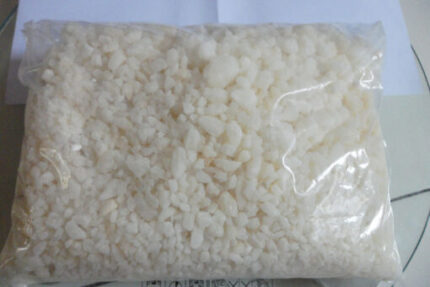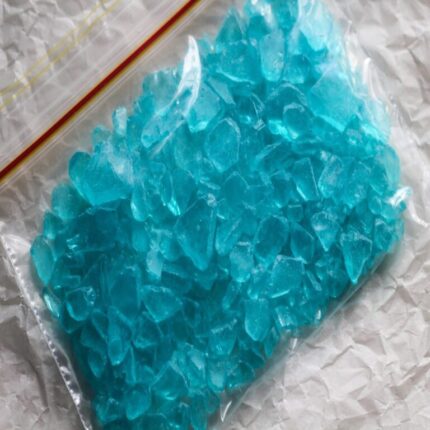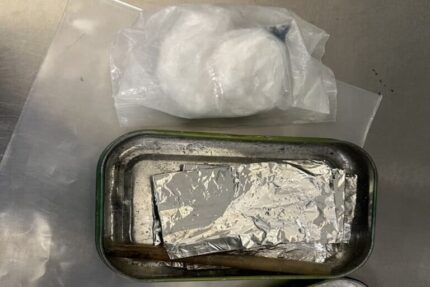Buy 2-NMC
Buy 2-NMC
2-NMC, short for 2-(Methylamino)-1-(3-methylphenyl)propan-1-one, is a synthetic compound classified as a substituted cathinone. Cathinones are a group of synthetic stimulants chemically related to the naturally occurring compound cathinone, found in the khat plant. These substances often mimic the effects of amphetamines, such as increased energy, alertness, and euphoria. Below are the chemical and physical properties of 2-NMC and other characteristics.Chemical Properties:
- IUPAC Name: N,2-Dimethyl-N-(4-methylphenyl)propanamide
- Chemical Formula: C₁₂H₁₇NO
- CAS Number: 849642-09-7
- InChI: InChI=1S/C12H17NO/c1-9(2)12(14)13(4)11-7-5-10(3)6-8-11/h5-9H,1-4H3
- InChI Key: GYXHTKZVPMDHQT-UHFFFAOYSA-N
- Canonical SMILES: CC1=CC=C(C=C1)N(C)C(=O)C(C)C
Physical Properties:
- Molecular Weight: 191.27 g/mol
- Appearance: Typically, compounds like this would appear as a solid or powder, likely white to off-white in color, though specific details on the physical appearance would depend on the form in which it is manufactured or handled.
- Boiling Point: Unspecified for this compound, but amides typically have high boiling points due to hydrogen bonding.
- Melting Point: Generally, amides with similar structures may have a melting point around 100-150°C, but this should be verified with specific data for this compound.
- Solubility: Likely to be soluble in organic solvents like ethanol or chloroform, but poorly soluble in water due to the hydrophobic nature of the aromatic ring and alkyl groups.
Other Characteristics:
- Class: Drugs of abuse and illegal drugs, often associated with sports doping.
- Functional Groups: Amide, aromatic ring, methyl groups.
- Mechanism of Action: As a drug of abuse, it may act on the central nervous system, though its exact pharmacodynamics are not fully detailed.
Buy A-PVP Crystal
Buy A-PVP Crystal
Buy Alprazolam Powder
Buy Alprazolam Powder
Alprazolam powder is a form of the medication alprazolam, which is commonly known by the brand name Xanax. It belongs to a class of medications called benzodiazepines, which are used to treat anxiety and panic disorders. Alprazolam works by enhancing the effects of a natural chemical in the body (GABA) to produce a calming effect on the brain and nerves. The powder form is typically used in pharmaceutical manufacturing to create tablets or capsules. It's important to use alprazolam only under the guidance of a healthcare professional due to its potential for dependence and side effects. Below is the chemical and physical properties of Alprazolam as follows:-
Chemical Properties:
- Chemical Formula: C17H13ClN4
- Molecular Weight: Approximately 308.76 g/mol
- Chemical Structure: It contains a benzodiazepine core with a triazole ring, which is characteristic of triazolobenzodiazepines.
-
Physical Properties:
- Appearance: White to off-white crystalline powder.
- Solubility: It is slightly soluble in water, but more soluble in organic solvents like ethanol and methanol.
- Melting Point: Typically around 228-229°C (442-444°F).
These properties make alprazolam suitable for formulation into various dosage forms, such as tablets and capsules, for medical use.
Buy Amphetamine Powder
Buy Amphetamine Powder
Amphetamine powder is a potent stimulant that directly impacts the central nervous system. It is commonly seen as an off-white or pinkish powder, sometimes appearing as small crystalline particles. Amphetamines have both medical and non-medical uses. Below we will examine the chemical and physical properties of Amphetamine.Chemical Properties:
- Chemical Formula: C9H13N
- Molecular Weight: 135.21 g/mol
- Structure: Amphetamine is a chiral compound, meaning it has two enantiomers: dextroamphetamine and levoamphetamine. The dextro form is more pharmacologically active.
- Solubility: It is soluble in water and alcohol, which makes it versatile for various formulations.
Physical Properties:
- Appearance: Amphetamine typically appears as a white, crystalline powder.
- Melting Point: The melting point of amphetamine is around 91-92°C (196-198°F).
- Boiling Point: It has a boiling point of approximately 203°C (397°F) at 760 mmHg.
- Odor: It generally has a faint, characteristic odor.
These properties make amphetamine a widely used substance in both medical and illicit contexts, primarily for its stimulant effects.
Buy BMK Oil (Benzyl Methyl Ketone)
Buy BMK Oil (Benzyl Methyl Ketone)
Physical Properties:
- Appearance: BMK Oil is typically a colorless to pale yellow liquid.
- Odor: It has a distinct, sweet, and floral odor.
- Boiling Point: Approximately 216-218°C (420-424°F).
- Density: Around 1.014 g/cm³ at 20°C.
- Solubility: It is soluble in organic solvents like ethanol, ether, and chloroform but has limited solubility in water.
Chemical Properties:
- Chemical Formula: C9H10O
- Molecular Weight: 134.18 g/mol
- Reactivity: BMK Oil can undergo typical ketone reactions, such as nucleophilic addition and oxidation.
- Stability: It is relatively stable under normal conditions but can be reactive with strong oxidizing agents.
When you buy BMK Oil online know that it is often used in the synthesis of various chemicals and pharmaceuticals, but it is also a precursor in the illicit production of certain drugs, which makes its handling and distribution highly regulated in many countries.
Buy Bmk Powder Online
Buy BMK Powder Online.
BMK Powder refers to Benzyl Methyl Ketone (BMK), also known by its chemical name 1-Phenyl-2-Propanone (P-2-P). It is typically found in liquid form but can also be processed into a powder. BMK is a colorless or slightly yellowish liquid with a characteristic odor and is a key precursor in organic synthesis. below are the chemical and physical properties of BMK powderBuy Buphedrone
Buy Buphedrone online.
Chemical Properties:
- Chemical Formula: C11H15NO
- Molecular Weight: 177.24 g/mol
- IUPAC Name: 2-(methylamino)-1-phenylbutan-1-one
- Structure: It contains a phenyl ring bonded to a butanone chain with a methylamino group.
Physical Properties:
- Appearance: Typically, buphedrone is found as a white crystalline powder.
- Solubility: It is soluble in water and organic solvents like ethanol.
- Melting Point: The exact melting point can vary, but it is generally in the range typical for cathinones.
Buphedrone is known for its stimulant effects, similar to other cathinones, and is often used recreationally. However, it is important to note that the use of buphedrone can be associated with health risks and legal issues in many jurisdictions.
Buy Butylone online
Buy Butylone Online
Butylone, or β-keto-N-methylbenzodioxolylbutanamine (βk-MBDB), is a synthetic psychoactive substance that acts as an entactogen, psychedelic, and stimulant. It belongs to the phenethylamine and cathinone classes of chemicals, which are known for their effects on the central nervous system with the following chemical and physical propertiesChemical Properties:
- Chemical Formula: C12H15NO3
- Molecular Weight: 221.25 g/mol
- IUPAC Name: 1-(1,3-benzodioxol-5-yl)-2-(methylamino)butan-1-one
- Structure: It contains a benzodioxole ring, a ketone group, and a butanamine chain.
Physical Properties:
- Appearance: Butylone typically appears as a white crystalline powder.
- Solubility: It is soluble in water and organic solvents like ethanol.
- Melting Point: The melting point of butylone is not well-documented, but similar compounds have melting points in the range of 100-150°C.
Butylone is often used in research settings and has been found in some recreational drug markets. It is important to note that the use and distribution of butylone may be regulated or illegal in many regions due to its psychoactive effects.
Buy Crystal Meth
Buy Crystal Meth Online.
Crystal meth, short for crystal methamphetamine, is a powerful and highly addictive stimulant that affects the central nervous system. It is known for its clear, chunky crystals resembling ice and is chemically similar to amphetamine. Crystal meth is often used recreationally for its intense euphoric effects, increased energy, and alertness. However, it is illegal in many places due to its high potential for abuse and addiction, and it can lead to severe physical and mental health issues, including heart problems, dental issues, and cognitive impairments.Crystal meth, or methamphetamine, is a powerful and highly addictive stimulant. Here are some of its chemical and physical properties:
Chemical Properties:
- Chemical Formula: C₁₀H₁₅N
- Molecular Weight: Approximately 149.24 g/mol
- Structure: Methamphetamine is a chiral compound, meaning it has two enantiomers: dextromethamphetamine and levomethamphetamine. The dextro form is more potent and is the one commonly abused.
- Solubility: It is soluble in water and alcohol.
Physical Properties:
- Appearance: Crystal meth typically appears as clear, chunky crystals resembling ice or glass, but it can also be found in powder form.
- Melting Point: Around 170-175°C (338-347°F)
- Boiling Point: Approximately 215°C (419°F) at 760 mmHg
- Odor: It is generally odorless, but impurities can give it a chemical smell.
These properties contribute to its potency and the ease with which it can be smoked, snorted, injected, or ingested, leading to its high potential for abuse and addiction.
Buy Ephedrine Crystals
Buy Ephedrine Crystals
Ephedrine crystals refer to a pure, crystalline form of ephedrine, a naturally occurring alkaloid with stimulant properties. It acts on the central nervous system and has sympathomimetic effects, meaning it stimulates the sympathetic nervous system, which is responsible for the "fight or flight" response. Ephedrine is primarily used in medicine for:- Preventing hypotension (low blood pressure) during anesthesia by helping to raise blood pressure.
- Bronchodilation – opening up the airways in the lungs to help people with asthma or chronic obstructive pulmonary disease (COPD) breathe more easily. It can also be used to treat bronchial constriction.
Chemical Properties:
- Chemical Formula: C₁₀H₁₅NO
Physical Properties:
- Appearance: Colorless or white solid crystals or powder.
- Taste and Odor: Bitter taste; either odorless or has a slight aromatic odor.
- Solubility: Soluble in water and alcohol, useful for various pharmaceutical applications.
- Melting Point: Around 187-188°C (369-370°F).
Buy Fentanyl powder
Buy Fentanyl Powder
For those thinking to buy Fentanyl powder is an illicit form of fentanyl, a synthetic opioid that is far stronger than many other opioids, including morphine and heroin. While fentanyl is medically prescribed for severe pain, such as post-surgery recovery or for patients with chronic pain, it is highly dangerous when abused or improperly used. In its powdered form, fentanyl is often mixed with other substances, increasing the risk of overdose, as it can be difficult to measure the correct dose. Fentanyl works by binding to the body's opioid receptors, which control pain and emotions. It can induce powerful effects such as pain relief, euphoria, and respiratory depression. The risk of overdose is especially high with fentanyl because its potency can easily lead to fatal respiratory depression if someone unknowingly consumes a dose too large for their tolerance. Even a tiny amount of fentanyl can be lethal, which is why its misuse is particularly hazardous. Fentanyl is also associated with a rise in overdose deaths, especially when it is mixed with other illegal drugs, often without the user’s knowledge. The compound with the chemical formula C₂₂H₂₈N₂O is likely a complex organic compound, though it is not a widely recognized or well-documented substance in common chemical databases. Based on the given details, here's an attempt to describe its chemical and physical properties:Chemical Properties:
- Molecular Formula: C₂₂H₂₈N₂O suggests an organic compound with nitrogen (N), oxygen (O), and carbon (C) atoms. It could be a type of amine or amide, or a related compound involving nitrogen and oxygen functionality.
- Functional Groups: The presence of nitrogen and oxygen hints that this compound could have functional groups such as amines (–NH₂), amides (–CONH₂), or ethers (–O–), but the exact functional groups would depend on the full structure.
- Reactivity: The compound may react under conditions typical for organic molecules containing nitrogen and oxygen, such as acid-base reactions, nucleophilic substitution, or ester hydrolysis (if an ester group is present). It may also undergo combustion, polymerization, or oxidation under certain conditions.
Physical Properties:
- Solubility: As stated, this compound is slightly soluble in water. The slight solubility is a characteristic common to many large organic compounds. The solubility could be influenced by the structure and intermolecular forces (e.g., hydrogen bonding, Van der Waals forces) in the compound.
- Form: The compound is described as solid and can exist in either a crystal or crystalline powder form. This suggests it has a defined and organized molecular structure capable of forming crystals.
- Boiling Point: The boiling point is not well-established. This could be due to a lack of detailed studies or because the compound may decompose before reaching a boiling point. Large organic compounds like this often have high boiling points, but specific data is required to be sure.
- Density: The density is also not well-established, but it can be speculated that its density would depend on its molecular weight and the packing arrangement of its solid form. Organic solids with similar molecular weights can have densities ranging from 1.0 to 1.5 g/cm³.
Buy Ketamine Injection
Buy Ketamine Injection Online.
Ketamine injection is primarily used as a dissociative anesthetic to induce loss of consciousness before and during surgery or medical procedures. It works by disrupting the transmission of pain signals in the brain while maintaining basic life functions, which makes it especially useful in certain medical contexts, including emergency medicine and for patients with unstable vital signs. It is typically administered by a healthcare provider through intravenous (IV) or intramuscular (IM) injection. Below are the chemical and physical properties of Ketamine injectionChemical Properties:
- Chemical Formula: C13H16ClNO
- Molecular Weight: Approximately 237.7 g/mol
- Structure: Ketamine is a chiral compound, typically used as a racemic mixture of its two enantiomers.
- Solubility: Ketamine is soluble in water and alcohol, which is important for its formulation as an injectable solution.
Physical Properties:
- Appearance: Ketamine Injection is usually a clear, colorless to slightly yellow solution.
- pH: The pH of the injectable solution is typically between 3.5 and 5.5.
- Formulation: It is available in various concentrations, commonly 10 mg/mL, 50 mg/mL, and 100 mg/mL.
These properties are crucial for its pharmacokinetics and pharmacodynamics, influencing how the drug is absorbed, distributed, metabolized, and excreted in the body.











